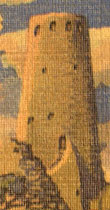I have tried, but I can’t see him. All the clips I can find on YouTube (there are many, and I’ve watched them for years) fail to bring him to life. Dribbling and cutting, leaping and heading, passing and shooting—it’s all there but somehow not there. He is The Most Photographed Barn in America. No: he is—Walker Percy got there long before DeLillo—the Grand Canyon.
Why is it almost impossible to gaze directly at the Grand Canyon under these circumstances and see it for what it is—as one picks up a strange object from one’s back yard and gazes directly at it? It is almost impossible because the Grand Canyon, the thing as it is, has been appropriated by the symbolic complex which has already been formed in the sightseer’s mind. Seeing the canyon under approved circumstances is seeing the symbolic complex head on. The thing is no longer the thing as it confronted the Spaniard; it is rather that which has already been formulated—by picture postcard, geography book, tourist folders, and the words Grand Canyon. . . . The highest point, the term of the sightseer’s satisfaction, is not the sovereign discovery of the thing before him; it is rather the measuring up of the thing to the criterion of the preformed symbolic complex.
Fancy talk, true, but germane. Oh to have been that Spaniard—García López de Cárdenas, I understand—who had no idea what he was going to see until the canyon opened up before his saucer-wide eyes. Or to to have been in Santos in 1954, dropping by one afternoon after work to watch the junior team practice. . . .
Percy imagines circumstances in which the Grand Canyon is see-able: Genuine visibility “may be recovered in a time of national disaster. The Bright Angel Lodge is converted into a rest home, a function that has nothing to do with the canyon a few yards away. A wounded man is brought in. He regains consciousness; there outside his window is the canyon.” But under what circumstances could Pelé be just there for us?
In Brazil, I think, they can see him because his eternal counterpart Garrincha creates parallax, binocular vision, depth of field. To non-Brazilians it’s surprising to learn how large Garrincha looms in the minds of the older people, and to note the exalted yet compassionate affection he inspired and still inspires, something different from, and more delicate than, the conventionally awed response to Pelé. As has often been noted, their traditional epithets are telling: Pelé was O Rei, the King, or O Rei do Futebol (of the game itself, considered universally and abstractly), but Garrincha was A Alegria do Povo, the Joy of the People. So also at the Maracanã in Rio it’s the home dressing room that’s named for Garrincha, the visitors’ for Pelé. As though the King must be kept at a distance.
For the rest of the world he stands simply alone, an ever-singular figure: the King, yes, but without the accompanying and contrasting Joy. This setting-apart started early: watch clips of the 1958 World Cup final, and you’ll see a group of Brazilian teammates lifting a weeping seventeen-year-old Pelé, who had scored twice, to their shoulders: he bends forward, covers his face with his hands, trying to fall back into the group. But they lift him up again, smiling, chapping him on the back. No, you’re different. Whatever you may want, you’re different. (As though they already discerned what the master narrative would be and were cooperating in writing it.)
But Garrincha—who created the first two Brazilian goals with incisive short-range crosses—where is he? Already being edited out of the public history, perhaps; which could only make him dearer to the People. I think: if I could feel for Garrincha what the Brazilians feel, perhaps I could see Pelé; but no, and no.
My nearest approach to such an experience happened during my college years in my native Alabama, when I agreed to go with a friend to a Leeds High School basketball game. There I saw something utterly freakish: an enormous fat kid with coiled-steel leg muscles and wild bursts of speed scoring forty-plus points in about twenty minutes of action, terrifying everyone on the court in the process. His name was Charles Barkley.
Read More: Pelé
by Alan Jacobs · August 16, 2010
[contact-form 5 'Email form']